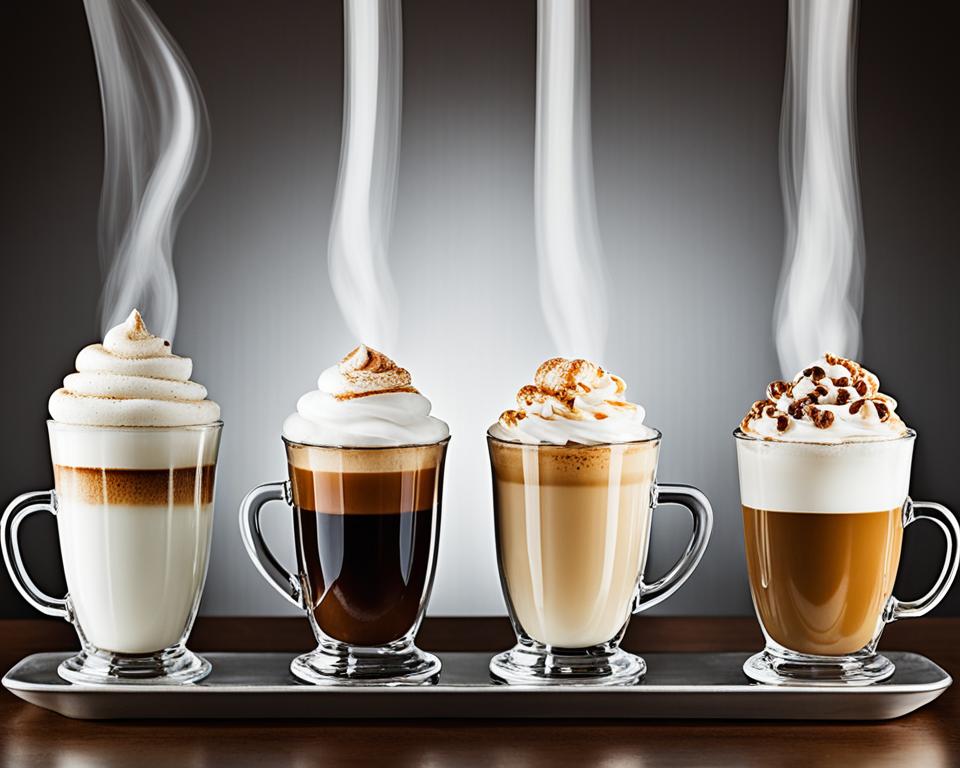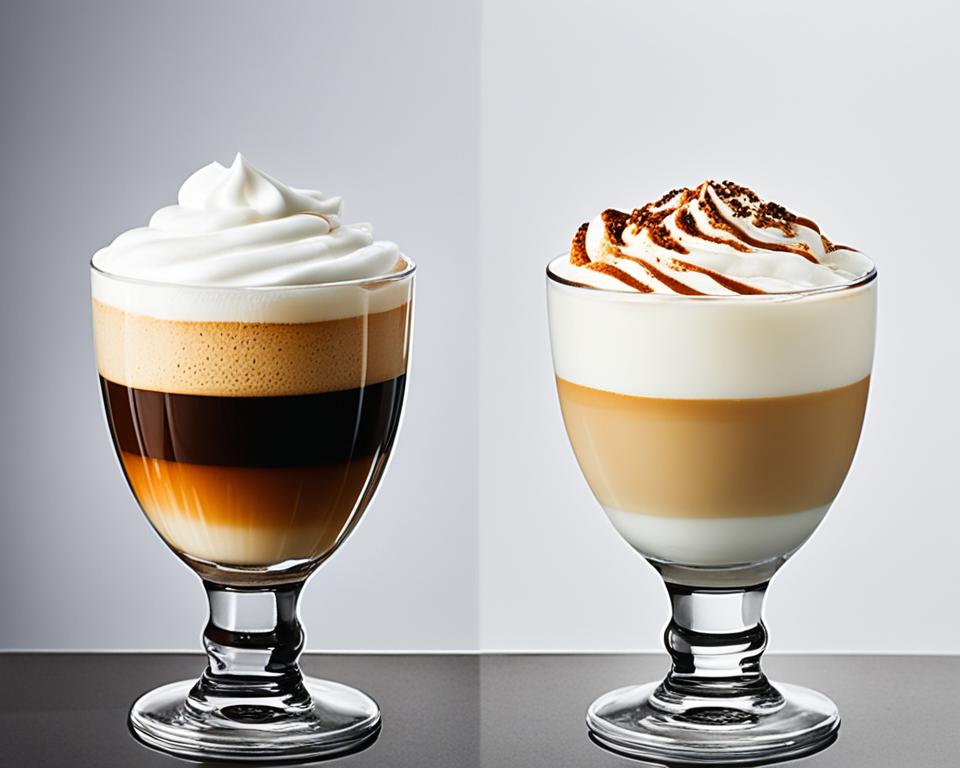It’s a crisp morning, and you stroll into your favourite coffee shop. You savour the comforting aroma of freshly brewed espresso-based drinks wafting through the air. As you approach the counter, you’re faced with a delightful dilemma—cappuccino or a latte?
This choice isn’t just about taste; it’s a glimpse into different coffee cultures and preferences, and it can transform your coffee experience.
We all have our go-to picks when it comes to milk coffee variations, but have you ever wondered about the actual differences between a cappuccino and a latte?
Sure, they both start with a base of rich, robust espresso, but how does that espresso mingle with milk to create two distinct beverages?
Today, we’re diving into a friendly coffee comparison that will clear up any confusion and deepen your appreciation for these beloved drinks.
Join me on this journey, and by the end, you’ll not only understand what makes each drink unique but also feel more connected to the rich traditions that have made cappuccinos and lattes staples in cafes worldwide.
Ready to explore the finest in coffee culture? Let’s get started!
Introduction to Cappuccino and Latte
The world of coffee is vast and fascinating, with a rich coffee culture that’s captivated many of us. Among the array of espresso drinks, two that often stand out for their creamy textures and frothy delight are the cappuccino and the latte.
Both beverages, born from the same espresso base, have carved out significant places in modern coffee culture.
Their unique ingredients and preparation methods have become staples in cafes worldwide. Who hasn’t savored the velvety foam atop a cappuccino or the smooth, milky goodness of a latte?

A cappuccino, traditionally, is a balance of equal parts espresso, steamed milk, and milk foam. This trio of components creates that signature frothy delight many of us adore.
On the other hand, a latte circles around a larger volume of steamed milk compared to its espresso, topped off with a light layer of foam—it’s a creamier, milder take on the world of espresso drinks.
In today’s bustling coffee culture, these two drinks have not only become popular choices but are also symbols of artisanship and skill.
Whether you’re at a quaint local café or a bustling Starbucks, the significance of these espresso drinks in our daily lives is undeniable.
History of Cappuccino and Latte
Cappuccino and latte both trace their origins to Italy, where coffee culture holds a special place. Let’s explore how these beloved drinks evolved to become staples in modern cafes.
The Origins of Cappuccino
Cappuccino history is deeply rooted in the Italian coffee tradition. This classic beverage began its journey in the 1900s, named after the Capuchin friars.
The drink’s name is a nod to the color of the friars’ robes, which matched the coffee’s light, frothy layer.
In Italy, it’s traditionally enjoyed in the morning and has become a global symbol of Italian coffee expertise.

The Evolution of Latte
While the cappuccino’s path is quite well documented, the latte’s history is slightly more obscure. Initially a straightforward breakfast beverage, it contained more milk than a cappuccino, making it smoother and less intense.
As it traveled across the ocean to America, it transformed significantly. American coffee innovation played a key role in popularizing the latte, introducing flavors and variations that made it a favorite among coffee aficionados in the States.
Main Ingredients and Their Impact
We all know that the relationship between ingredients can turn an average coffee into something extraordinary.
Let’s break down the essential role each ingredient plays in both a cappuccino and a latte.
The Role of Espresso
The foundation of both drinks is the espresso shot. These espresso shots not only serve as the base but significantly influence the coffee flavor.
A well-pulled espresso shot sets the stage for a perfect cup, offering a rich and robust taste.
The quality of the espresso matters. Freshly ground beans, the right grind size, and the right water temperature can make or break the coffee flavor.
An espresso that’s too bitter or sour will negatively impact the overall taste experience of both cappuccinos and lattes.
The Importance of Milk
Milk plays a transformative role, enhancing the richness of the drink. The texture and temperature of steamed milk vary between cappuccinos and lattes.
Frothy cappuccinos thrive on the velvety foam layer, which adds both visual appeal and a creamy mouthfeel.
For lattes, the milk should be steamed to a silky-smooth consistency, allowing the coffee flavor to shine through without being overpowered.
Also, foam art adds a delightful touch, turning every cup into a visual masterpiece. It’s not just about the taste but also about the enjoyment and experience of the coffee.
Cappuccino vs. Latte: The Main Differences
When it comes to a real comparison, distinguishing cappuccino from latte isn’t just about the name. The milk-to-espresso ratio plays a key role.
In a traditional cappuccino, the milk-to-espresso ratio leans more heavily on the espresso, giving it a bold kick.
In a latte, the ratio swings the other way with more milk, resulting in a smoother, creamier drink.
Have you ever noticed the texture contrast between these two drinks? A cappuccino has a distinct texture due to its thicker foam, which creates a delightful layering effect.
A latte’s foam, on the other hand, is much finer and integrates more smoothly with the milk, offering a more uniform texture overall.
This textural difference also impacts the flavor; the cappuccino’s frothiness pairs with a strong espresso punch, while the latte provides a balanced, mellow experience.
Another aspect worth mentioning is the serving size. Traditionally, cappuccinos are served in smaller cups, showcasing their strong espresso flavor.
Lattes usually come in larger cups, accommodating the increased milk content. This difference in size further emphasizes each drink’s unique properties.
So, next time you’re at your favorite coffee shop and faced with a choice, you’ll know that it’s not just a name difference but a full sensory experience that sets them apart.
Whether you crave the espresso-heavy hit of a cappuccino or the milky comfort of a latte, understanding their core differences makes for a more enjoyable coffee adventure.
How to Make a Perfect Cappuccino
Becoming a home barista is easier than you think. With the right cappuccino recipe and techniques, you can enjoy café-quality coffee at home.
Let’s dive into a step-by-step guide to brewing the perfect cappuccino.
Step-by-Step Guide
First, prepare your espresso. Use freshly ground coffee beans and ensure your espresso machine is set to the right pressure. Pull a double shot of espresso into your favorite cup.
Next, focus on frothing milk. Pour cold milk into a metal pitcher and insert the steam wand just below the surface. As you froth the milk, move the pitcher in a circular motion to create microfoam.
Combine the elements by pouring the frothed milk over your espresso. The milk should have a velvety texture. For a classic cappuccino, aim for equal parts espresso, steamed milk, and milk foam.
Tips and Tricks
To perfect your cappuccino recipe, ensure your espresso machine is well-maintained and clean. Fresh coffee beans make a world of difference, so invest in a quality grinder.
For frothing milk, practice makes perfect. Adjust steam pressure based on your preferences.
Consider experimenting with different milk types. While whole milk is traditional, options like oat and almond milk can add unique flavors.
Keep an eye on milk temperature; it should not exceed 150°F to avoid scalding.
As a home barista, honing your barista techniques will enhance your coffee-making experience. Focus on creating a smooth, creamy texture in your milk.
Practice latte art to make your cappuccinos visually appealing.
By incorporating these barista techniques, you can master the art of making a perfect cappuccino. Remember, a great cappuccino is a delicious blend of a good espresso shot and properly frothing milk. Enjoy your brewing journey!
What Are the Key Differences Between a Cappuccino and a Latte?
Cappuccinos and lattes both originate from espresso but differ in their milk content. A cappuccino features equal parts espresso, steamed milk, and frothy milk foam, creating a rich texture. In contrast, a latte has more steamed milk and less foam. Thus, understanding the classic espresso drink cappuccino highlights its unique frothy charm.
How to Make a Delicious Latte
If you love a smooth and creamy latte like I do, you’re in the right place. Making a perfect latte at home is easier than you may think.
You just need a few key tools, ingredients, and a little patience. Let’s walk through the latte recipe step-by-step.
Step-by-Step Recipe
First, brew a strong shot of espresso. If you have an espresso machine, that’s perfect, but a stovetop espresso maker works too.
While the espresso is brewing, heat your milk. Whole milk gives the best texture, but you can use any milk you like.
Use a frother to steam the milk until it’s hot and frothy. If you don’t have a frother, a saucepan and whisk can do the trick.
Pour the espresso into your favorite mug, then slowly add the steamed milk, holding back the foam with a spoon.
Finally, spoon the foam on top of your latte. Voila! You’ve made a delicious latté. Feel free to get creative with latte art or add a sprinkle of cinnamon for an extra touch.
Common Mistakes to Avoid
Even with the best instructions, coffee preparation can sometimes go awry. One common mistake is overheating the milk.
Milk that’s too hot can scald, leading to an unpleasant taste. Aim for about 150°F, which is warm but not burning.
Another pitfall is not brewing the espresso correctly. Remember, it should be strong and robust, not weak or watery.
Make sure you use fresh, finely ground coffee and tamp it down evenly in the portafilter.
Lastly, milk-frothing errors can ruin your latte. Don’t overfroth the milk; you want a velvety texture, not big bubbles.
Take your time, and practice makes perfect. With these tips, you’ll be well on your way to mastering the art of latte-making. Enjoy your next latte!
FAQ
What is the main difference between a cappuccino and a latté?
The main difference lies in the milk-to-espresso ratio and texture. A cappuccino has an equal amount of espresso, steamed milk, and milk foam, resulting in a lighter, frothier texture. A latte, on the other hand, contains more steamed milk and a thin layer of foam, giving it a creamier, smoother texture.
Which drink is stronger in flavor, a cappuccino or a latte?
A cappuccino typically has a stronger espresso flavor because it contains less milk, which dilutes the taste of the espresso. A latte, with more steamed milk, tends to have a milder and creamier taste.
How do the histories of cappuccino and latte differ?
Cappuccino has its roots in Italy and is named after the Capuchin friars, whose brown habits resemble the color of the drink. The latte, though originally Italian as well, gained its popularity and unique evolution in the United States, becoming an iconic coffeehouse staple with various adaptations.
What role does espresso play in both cappuccinos and lattes?
Espresso is the base for both drinks. The quality and preparation of the espresso shot are crucial, as they determine the drink’s flavor and overall experience. A well-balanced shot of espresso leads to a better cappuccino or latte.
How important is the milk preparation in cappuccinos and lattes?
Milk is essential to both drinks, but its preparation varies. For cappuccinos, milk should be steamed to achieve a light, airy foam. For lattes, milk should be steamed to a creamy, smooth consistency with minimal foam. The right steaming technique enhances the texture and flavor of the final beverage.
Can you give a step-by-step guide to making a perfect cappuccino at home?
Sure! First, pull a fresh shot of espresso. Then, steam milk until it’s light and frothy. Pour the espresso into a cup, followed by the steamed milk, and top it off with milk foam. You can also sprinkle some cocoa or cinnamon on top for an extra touch.
Are there any tips and tricks for making a better cappuccino?
Absolutely! Use fresh, high-quality coffee beans, and grind them just before brewing. Practice your milk-frothing technique to achieve the right foam-to-milk ratio. Also, ensure your equipment is clean and properly maintained for the best results.
How do I make a delicious latté at home?
Start by pulling a fresh shot of espresso. Steam milk until it becomes creamy with a thin layer of foam. Pour the steamed milk into the cup with the espresso, leaving a small amount of foam on top. You can add flavored syrups or spices to customize your latte.
What are some common mistakes to avoid when making a latté?
Avoid over-steaming the milk, which can result in burnt flavor or too much foam. Ensure the espresso shot is not bitter or over-extracted. Lastly, use fresh milk and quality coffee beans for the best taste.




